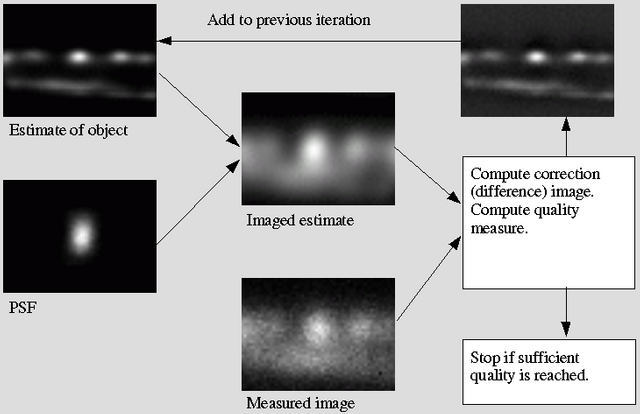Non-linear iterative restoration methods
Iterative form of a deconvolution algorithm
The basic idea of iterative Image Restoration methods is to optimize some quality measure of the object estimate.
- A synthetic image of a (smart) initial estimate of the object is compared to the measured image.
- The result of the comparison is used to improve the estimate.
- The new estimate is used to compute a new synthetic image which is again compared to the measured image, and so on.
- When the 'difference' between the synthetic image and the measured image reaches some minimum the procedure is stopped.
Advantage: quality, versatility (WF, 2D, noisy data). Disadvantage: slow.
All restoration techniques are based on some definition of a Quality Criterion. Ultimately, it is the choice of this criterion which determines the outcome.
The diagram below shows how the 'van Cittert' algorithm attempts to achieve this. The van Cittert algorithm minimizes the difference image obtained by subtracting the 'imaged' estimate and the recorded image. Iterations are started for instance by setting the first estimate to the measured image.
- Make a (smart) initial estimate of your object.
- Convolve this estimate with the PSF.
- Compare the result with the image from the microscope.
- To the difference a quality measure is assigned.
- With this quality measure the estimate is improved.
- Start again with step 2

It can be shown that the iterations converge to direct inversion if they converge. Still, with this technique we can now:
- Force a positivity constraint by clipping each new estimate. Importantly, this allows recovery of lost spatial frequency components.
- Stop if noise amplification becomes too severe.
Non-linearity is introduced in the algorithms, for example, with the mentioned positivity constraint or using a Regularization Parameter.
Iterative methods
- Iterative forms of inverse filtering:
- van Cittert: iterative form of direct inversion, with or without positivity constraint.
- Landweber method: steepest descent optimization form of Tikhonov-Miller (TM) with(out) positivity
- Conjugate gradients algorithm to minimize the TM difference criterion, with(out) positivity: Iterative Constrained Tikhonov-Miller (ICTM). Advantage: fast, memory-efficient and reliable algorithms available. Suitable for restoration of low noise wide field images.
- Maximum Likelihood Estimation (MLE)
- Expectation-maximization algorithm (EM). Suitable for restoration of noisy confocal and two-photon images.
- Different a-priori image models possible like Good's roughness, Gaussian, Maximum entropy.
- Fast conjugate gradients implementations possible.
